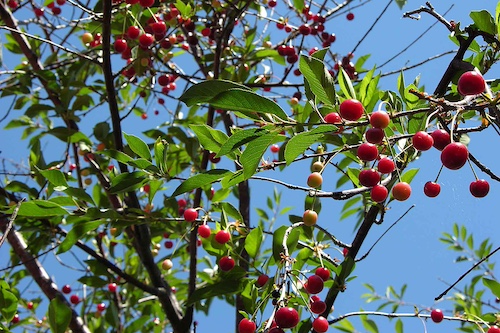Lesvos, an island for food lovers, is faraway from the busy Greek cities of Athens and Thessaloniki. It lies in the Eastern Aegean, embraced by Turkey, with whom it shares a past of wars and land grabbing. A little more than a century ago the island was at the centre of a population exchange between Greece and Turkey. The Turks were thrown out of Greece and the Greeks had to pack their bags in Turkey. All these refugees brought with them interesting recipes from Minor Asia to Lesvos, for instance Imam Baildi and baklava.
Another thing contributing to Lesvos being an important culinary island is that the inhabitants like to drink ouzo. This is always served with a little snack (mèze): a little fish, a piece of cheese, a bite of a vegetable; small dishes with whatever is available. This ouzo-snack-culture has grown into a real food fest.
However, the main reason why the food on Lesvos is so delicious is that many products arrive ‘red-hot’ from the land or the sea onto your plate. Growing vegetables is hobby number one on the island. Everywhere you will see sheep, goats, pigs, cows and chickens roaming around. Small fishing boats float on the sea whenever the weather permits. In the Bay of Kalloni swim the best sardines of Greece (papalina), having as company lovely shells like mussels and oysters.
Everywhere on the island there are olive trees that can produce an excellent oil. There are chestnut and fig trees, many gardens house almond, lemon, orange and other fruit trees like prunes or apricots. Each region has its own speciality: Mandamados is known for its tasty cheeses; for figs you’d best go to Eresos; Anemotia makes wine and also a tsipouro that’s as good as whisky. Plomari brews ouzo, you get oranges nearby Mytilini as well as in Parakila, In Skala Polichnitos and Skala Kalloni you will find mountains of salt and Sigri has fish.
Nestled between the slopes of the Olympus mountain range is the village of Agiasos, which has the biggest pantry of Lesvos: chestnuts, apples, pears and cherries. Maybe the cherries were planted there in order to lure the Gods of the Big Olympus on the mainland to the island: in ancient times it was said that a cherry had an elixir that gave the gods immortality.
The origin of the cherry lies in Minor Asia; they are named after a village called Cerasus, nowadays Girasus on the Black Sea. Turkey happens to be the number one country in the world for producing cherries. The first time kerasia (Greek name for cherries) were named and described, was by the Lesvos born Theophrastus and it was the Greeks who started cultivation of cherries — followed by the Romans who spread the cherry culture further into Europe.
This weekend is the Cherry Festival in Agiasos and cars fully stuffed with cherries are driving up and down the roads there. Olives are beaten out of the trees, something you cannot do with soft cherries. They must be picked by hand. One large tree can contain as many as 7000 cherries. Picking cherries could easily join the list of the twelve tasks of Hercules.
No wonder that, after so much work, the end of the harvest is much celebrated. The inhabitants of Agiasos love to party. They are well known for their colourful days of Carnival with dances, theatre and music. Around the Ascension of Mary, on August 15, the village is flooded with hundreds of pilgrims that come to kiss a famous Mary-Icon in the Panayia Vrefokratousa church, after which they can participate in many festivities. At the start of November it is time for roasted chestnuts (a speciality at the Chestnut festival). In early summer, music is made and dances are performed around the crates full of cherries and the traditional Sfougata can be eaten, a dish with eggs, eggplants, feta, ladotiri (a local cheese) and herbs.
The trees causing all this hubbub are to be found in the fairytale woods on the slopes of Olympus. There the many trees and shrubs create a magical green world, and in their shadows many flowers light up in the dark. Because Minor Asia is close by and migrating birds love to stop at Lesvos, this mountainous region has some 1,400 different species of flora, like rare orchids and pine trees. It is here that the cherry trees are hiding, along with small apple, pear and mighty chestnut trees, as well as many lazy vegetable beds, bordered by colourful roses. Agiasos might well be the most beautiful mountain village of Lesvos, but its surrounding area under the grey and barren top of the Olympos mountain range is even more impressive for its fertile woods. A Garden of Eden that makes you want to cross it with a shopping cart.











